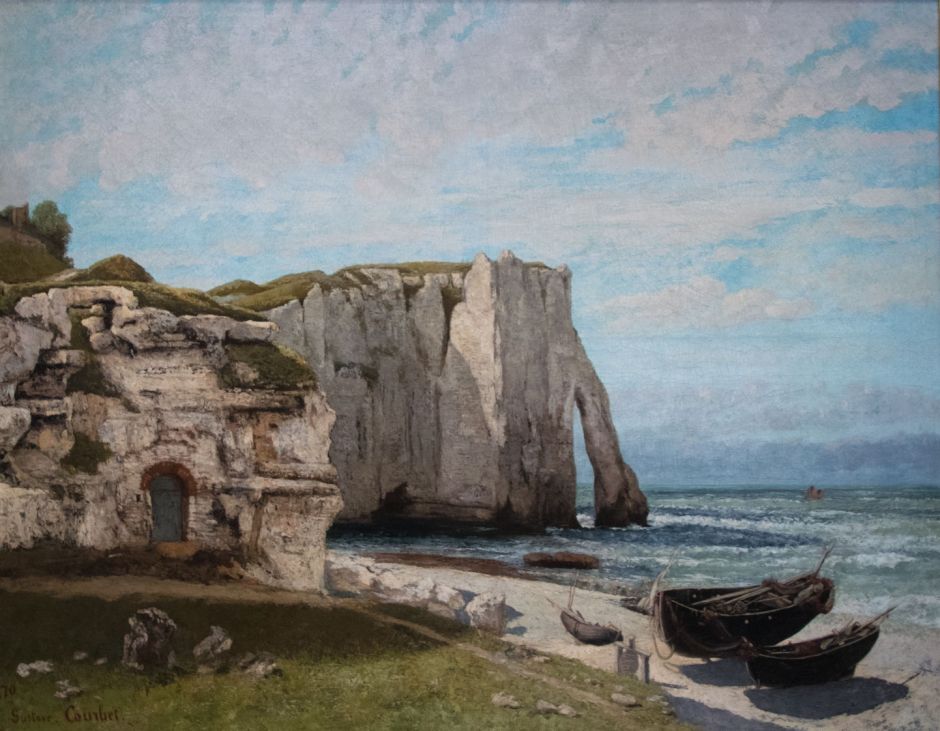The north coast of France played an important role in European art history, particularly in the nineteenth century. When Claude Monet was four, he and his family moved from Paris to live in Le Havre, where he first started painting and learned from Eugène Boudin, who had also been brought up in the town. To the north-east of Le Havre, between its busy port and the coastal town of Fécamp, is a series of four chalk headlands, at the end of which is the seaside resort of Étretat, then a small fishing village.
The chalk cliffs here are famous for the unusual effects of erosion, which has left pinnacles and one spectacular arch, known as the Manneporte.
Sleepy Étretat saw the occasional topographic illustrator prior to 1850, but hadn’t made it onto the list of locations which landscape painters should visit.

Although Étretat is fairly close to Le Havre, the first pre-Impressionist artist who appears to have painted it wasn’t Boudin, but Johan Jongkind, who visited it in 1852.
If I had to pick one of his paintings which most heralded Impressionism, it would be this marvellous view of Étretat Harbour, painted in the rich colours of sunset.
By a strange coincidence, the previous year Eugène Lepoittevin, who had fallen in love with the Normandy coast, had a chalet built for him in Étretat. The successful author Guy de Maupassant, then a young man, lived only a hundred meters away, and the two became friends. Lepoittevin also had a studio built by the sea, and started to paint the village, beaches, and the spectacular cliffs.

Lepoittevin’s Bathing, Étretat Beach (1864) was exhibited at the Salon in 1865, where it was bought by Napoleon III. Disappointingly, this looks out to the Channel and doesn’t show any of the local cliffs. Indeed, it could have been painted almost anywhere along that coast.

Lepoittevin continued to paint coastal scenes in his studio by the beach, including this of Bathing at Étretat from 1866, probably the most detailed view of the cliffs there in realist style. This shows one of the headlands in the background, and was painted from a beach to the south-west of the Manneporte, which isn’t visible here.

It’s Lepoittevin’s undated view of Fishermen at Étretat which shows the ‘other’ side of the famous chalk arch, where local fishermen gathered on the beach to prepare their nets and tackle. This is the beach in front of the village of Étretat.
Lepoittevin died in 1870, just as an even more famous artist was starting to visit Étretat: Gustave Courbet.

Courbet visited the village in 1870, where he painted this tranquil view of The Cliff at Étretat after a Storm. It’s also claimed that he started to paint his radical series of waves on the coast here, possibly using Lepoittevin’s former studio.

A few years later, Courbet achieved early Impressionist style in his Boats on a Beach, Étretat (c 1872-75), which was painted around the corner from the Manneporte.

By this time, Étretat was on the landscape artists’ map, and attracting a great deal more attention. The American landscape artist George Inness visited in the mid-1870s, during his European tour which had included Italy as well as France. His view of Sunset at Étretat (c 1875) must be one of the most traditional.

Another visitor in the 1870s was Camille Corot, who painted The Beach, Étretat in 1872. Again, he opted for a view around the corner from the Manneporte.

Meanwhile, the young Claude Monet first painted here in 1864, in this view of Étretat showing the headland nearest the village and the Manneporte. He doesn’t appear to have painted here again until the 1880s, and it’s then that I take up the story in the second and concluding article tomorrow.

